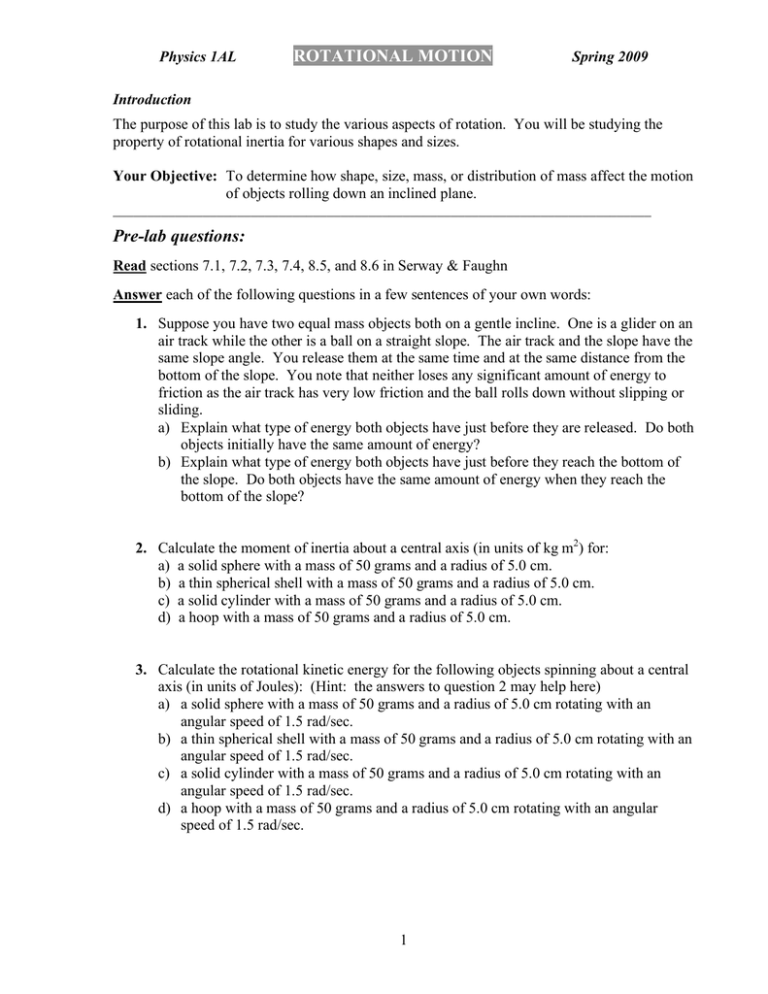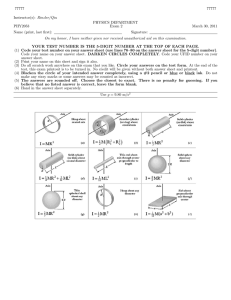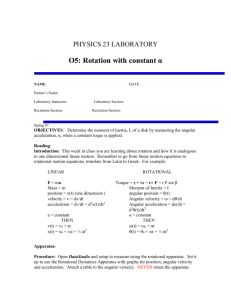ROTATIONAL MOTION
advertisement

Physics 1AL ROTATIONAL MOTION Spring 2009 Introduction The purpose of this lab is to study the various aspects of rotation. You will be studying the property of rotational inertia for various shapes and sizes. Your Objective: To determine how shape, size, mass, or distribution of mass affect the motion of objects rolling down an inclined plane. ______________________________________________________________________________ Pre-lab questions: Read sections 7.1, 7.2, 7.3, 7.4, 8.5, and 8.6 in Serway & Faughn Answer each of the following questions in a few sentences of your own words: 1. Suppose you have two equal mass objects both on a gentle incline. One is a glider on an air track while the other is a ball on a straight slope. The air track and the slope have the same slope angle. You release them at the same time and at the same distance from the bottom of the slope. You note that neither loses any significant amount of energy to friction as the air track has very low friction and the ball rolls down without slipping or sliding. a) Explain what type of energy both objects have just before they are released. Do both objects initially have the same amount of energy? b) Explain what type of energy both objects have just before they reach the bottom of the slope. Do both objects have the same amount of energy when they reach the bottom of the slope? 2. Calculate the moment of inertia about a central axis (in units of kg m2) for: a) a solid sphere with a mass of 50 grams and a radius of 5.0 cm. b) a thin spherical shell with a mass of 50 grams and a radius of 5.0 cm. c) a solid cylinder with a mass of 50 grams and a radius of 5.0 cm. d) a hoop with a mass of 50 grams and a radius of 5.0 cm. 3. Calculate the rotational kinetic energy for the following objects spinning about a central axis (in units of Joules): (Hint: the answers to question 2 may help here) a) a solid sphere with a mass of 50 grams and a radius of 5.0 cm rotating with an angular speed of 1.5 rad/sec. b) a thin spherical shell with a mass of 50 grams and a radius of 5.0 cm rotating with an angular speed of 1.5 rad/sec. c) a solid cylinder with a mass of 50 grams and a radius of 5.0 cm rotating with an angular speed of 1.5 rad/sec. d) a hoop with a mass of 50 grams and a radius of 5.0 cm rotating with an angular speed of 1.5 rad/sec. 1 Physics 1AL ROTATIONAL MOTION Spring 2009 LAB WORK A. Angular Acceleration of a Rotating Disk Introduction: This experiment uses a disk rotating about a vertical axis through the center of the disk. A string is tied to a pulley which is attached to the disk. The disk experiences a torque, τ, provided by a hanging mass which is attached to the other end of the string as shown in the figure to the right. You will be examining the angular acceleration of two shapes: a solid disk and a thick hollow ring. We will be focusing on the hanging mass for the measured values of this experiment. The hanging mass would fall at a rate of 9.8 m/s2 except that it has a tension force due to the string that is slowing it down. Our goal is to find the acceleration value of the hanging mass, ay, by measuring the time it takes for the mass to fall a given value, Δy. The distance that the hanging mass (which is initially at rest) will fall is given by the following equation: 1 "y = at 2 2 There are two forces causing this acceleration: the force due to gravity on the hanging mass and the tension force due to the string. From the measured acceleration value and by calculating the force due to gravity, you will calculate the tension force due to the string on the hanging mass. ! The tension force is also creating torque on the rotating disk which is causing an angular acceleration. We can calculate the torque due to the tension force from the following equation: (Στ = rF), where r is the radius value is the distance from the central axis of the rotating disk to the place where the string attaches. We can then calculate the angular acceleration of the disk from the following equation: (Στ = Iα), where I is the moment of inertia of the rotating disk. The value for angular acceleration, α, is our final goal. A1. Start by measuring the distance that the mass will drop when you are conducting the experiment. The mass will start at some initial value and drop to a final value due to the length of the string. This measured value will be your Δy distance for your equation. A2. Make sure the string passes over the pulley and attaches to the solid disk. If you want, you may ask your TA if the setup is accurate. A3. Now perform the experiment by taking the mass up to its initial value and releasing it. Measure the time it takes for the mass to fall the distance Δy with a stopwatch. Repeat the experiment five times is order to get an accurate time value. A4. Record all five time values in your notebook. Take the average value for time to calculate the acceleration of the hanging mass. A5. Draw a force diagram for the hanging mass. From this diagram write an equation based on Newton’s 2nd Law (ΣF = ma) to find the tension force due to the string on the 2 Physics 1AL ROTATIONAL MOTION Spring 2009 hanging mass. (Hint: you can easily calculate the value for the force due to gravity on the hanging mass.) A6. From the value of acceleration found in A4 and the equation you derived in A5, calculate the tension force due to the string on the hanging mass. A7. Measure the distance from the central axis to the location of the string that is wrapped around the rotating disk. This is the radius value that is providing the torque that is making the disk rotate. A8. Calculate the magnitude of torque on the disk from the tension force you calculated in A6 and from the radius value you measured in A7. A9. Calculate the moment of inertia of the rotating disk (refer to pre-lab question 2 for all of the parameters you will need to find for each object). A10. Finally, calculate the angular acceleration, α, value for the rotating disk from the moment of inertia you calculate in A9 and the torque value you calculated in A8. A11. Repeat steps A1 to A10 for the thick hollow ring. Your final goal is the angular acceleration value for the hollow ring. (Note: the moment of inertia of a thick hollow 1 m R 2 + R22 ) ring is: 2 ( 1 , where m is the mass of thick hollow ring, R1 is the inner radius of the thick hollow ring, and R2 is the outer radius of the thick hollow ring.) A12. Which shape had the greatest value for angular acceleration? Which shape had the ! greatest moment of inertia? B. Shape Races In this experiment, you will take a variety of objects and try to race them down a straight slope For each race make sure you release the objects at the same height and at the same time (a ruler usually accomplishes this task well enough). There are four objects that you will be racing: a solid sphere, a hollow ring, a large radius solid disk, and a small radius solid disk. Make sure you have all four objects. Race the objects in pairs. B1. Before you conduct any of the races, you need to make predictions for the various shapes. Discuss as a group which shapes would win for the following object races: 1) A large radius solid disk vs. a hollow ring. 2) A large radius solid disk vs. a solid sphere. 3) A solid sphere vs. a hollow ring. 4) A small radius solid disk vs. a hollow ring. 5) A large radius solid disk vs. a small radius solid disk. B2. After you have made your predictions, write them down in your notebook and discuss them with your TA. B3. Conduct the races between the shapes that you predicted in B1. Write down the results of the actual races in your notebook. Make sure you race each pair at least five times so that the results are obvious. 3 Physics 1AL ROTATIONAL MOTION Spring 2009 B4. Which shape in your collection is the overall fastest? Which shape in your collection is the overall slowest? B5. Measure the mass and radius of each shape. B6. Calculate the moment of inertia of each object in the race (refer to pre-lab question 2 for all of the parameters you will need to find for each object). B7. Which shape in your collection has the greatest moment of inertia? Which shape in your collection has the least moment of inertia? Post-lab Activity: (Note: for Post Lab 8 you have two choices: 1) to complete the problem below or 2) complete a survey, see the next page for instructions. No matter which choice you make, you will still need to write-up a conclusion for Lab 8.) 1. Suppose you have two equal mass objects both on a gentle incline. One is a glider on an air track while the other is a ball on a straight slope. The air track and the slope have the same slope angle. You release them at the same time and at the same distance from the bottom of the slope. You note that neither loses any significant amount of energy to friction as the air track has very low friction and the ball rolls down without slipping or sliding. Which object will reach the bottom first? Explain why one will beat the other, or why you think they will be the same. 2. A solid disk is rolled down an inclined plane (without slipping). The disk has a mass of 1.0 kg and a radius of 50.0 cm. The disk is initially placed at a height of 1.5 m. What is the linear velocity of the disk at the bottom of the inclined plane? 4 Physics 1AL ROTATIONAL MOTION Spring 2009 Invitation to participate in a survey on students in physics The purpose of this announcement is to extend to you an invitation to participant in the survey portion of a research study about the experiences, beliefs and perceptions of students enrolled in physics lab classes. You have been asked to take part because you are currently enrolled in a physics lab class (i.e., Physics 1AL, 1BL, 1CL, 2AL, 2BL, or 2CL). The principal research investigator is Dr. Tricia Bertram Gallant. The purpose of this study is to determine the services and education that UCSD can provide to enhance student success and learning in physics labs. There will be approximately 2800 participants in this study and we will be conducting the study over the course of the 2008-2009 academic year. For each physics lab course you enroll in this year, you will receive an invitation to complete the survey so you could complete the survey as many as three times, but participation is completely voluntary. If you volunteer to participate in this survey portion of the study, you can access the survey via the link below. Completing the survey should take no longer than 15 minutes. https://physics-apps.ucsd.edu/survey/phpQ/fillsurvey.php?sid=2 You may sense discomfort responding to questions about your academic experiences, but you can refuse to answer any questions you wish and end the survey at any time. Participation in research is entirely voluntary. You may refuse to participate or withdraw at any time without jeopardy to you of any kind. If you complete the survey, please print off the confirmation page at the end and submit it to your physics lab TA for academic credit (in lieu of completing the post-lab 8 assignment). If you would rather not complete the survey, you can choose to complete the post-lab 8 assignment as an alternative option for earning your academic credit. Individual survey responses will be kept confidential and your responses anonymous; we will not be tracking your individual responses in anyway, including to an IP address. Neither your course instructor or your teaching assistant(s) will see your individual responses. By clicking on the survey link, you indicate your agreement to participate in this research study. Completing the survey should take less than 15 minutes. At the end of the survey, you will receive a confirmation of completion; please print that out and submit it in your physics lab to receive your academic credit. If you have additional questions or need to report-research related problems, you may contact the principal investigator at tbg@ucsd.edu or 858-822-2163. You may also call the Human Research Protections Program at 858-455-5050 to inquire about your rights as a research subject or to report research related problems. Sincerely, Tricia Bertram Gallant, Ph.D. Principal Investigator The UCSD Institutional Review Board has reviewed and approved this research involving human subjects. 5





